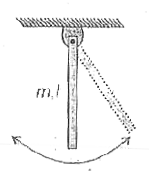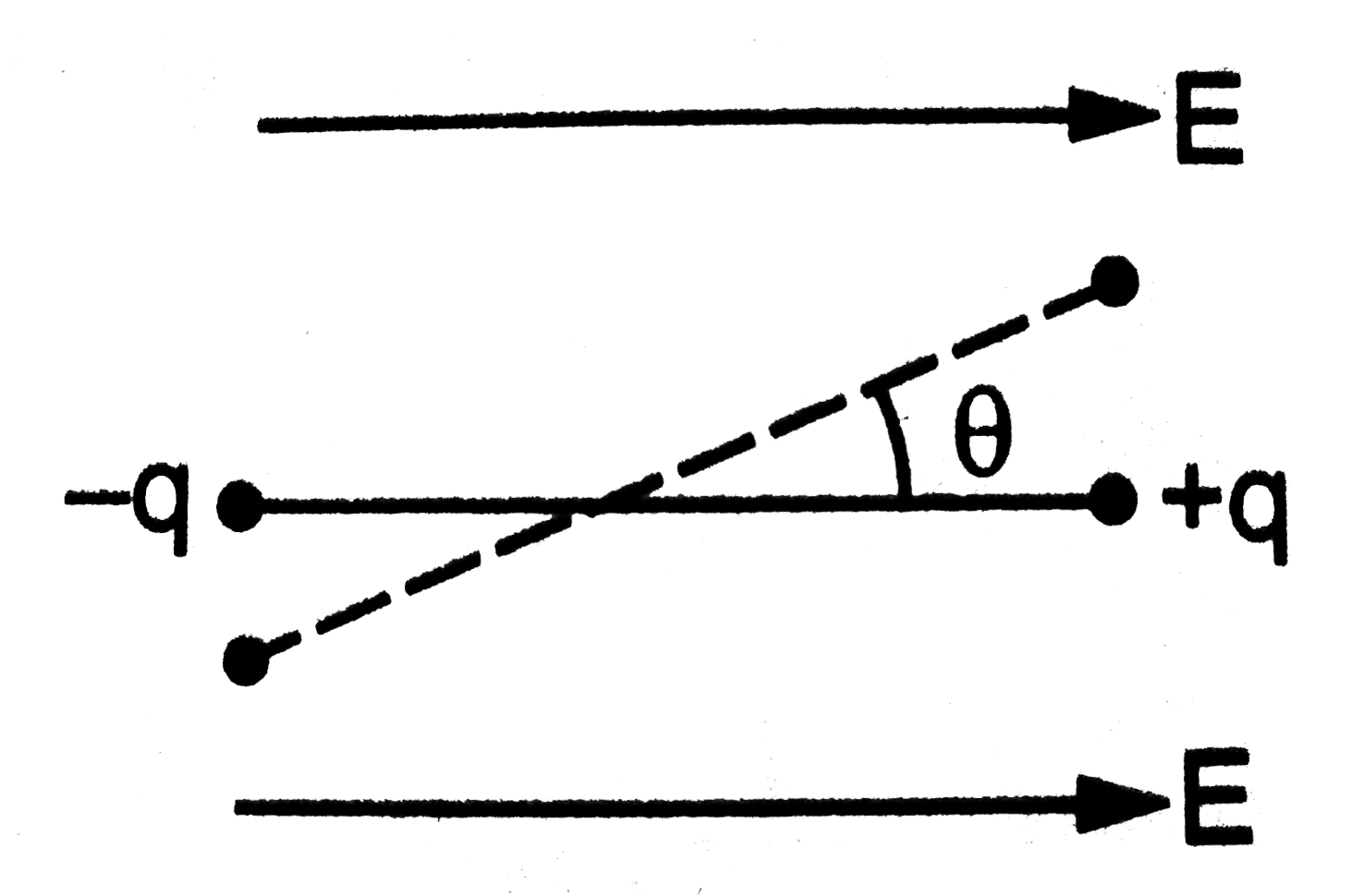Two particles, carrying charges -q and +q and having equal masses m each, are fixed at the rod is clamped at an end and is placed in a uniform electric field E with the axis of the dipole along the electric field. The rod is slightly tlted and then released. Neglecting gravity find the time period of small oscillations.
To find the time period of small oscillations of the dipole in a uniform electric field, we can follow these steps:
Step 1: Understand the System
We have a dipole consisting of two charges, -q and +q, separated by a distance d. The dipole is placed in a uniform electric field E with its axis aligned along the direction of the electric field.
Step 2: Define the Electric Dipole Moment
The electric dipole moment P is defined as:
P=q⋅d
where q is the magnitude of one of the charges and d is the distance between the charges.
Step 3: Analyze the Forces Acting on the Charges
When the dipole is tilted by a small angle θ, the positive charge +q experiences a force F+=qE in the direction of the electric field, while the negative charge −q experiences a force F−=−qE in the opposite direction. The net torque τ acting on the dipole due to these forces can be expressed as:
τ=P⋅E⋅sin(θ)
For small angles, sin(θ)≈θ, so we can simplify this to:
τ≈P⋅E⋅θ
Step 4: Relate Torque to Angular Acceleration
The torque can also be expressed in terms of the moment of inertia I and angular acceleration α:
τ=I⋅α=I⋅d2θdt2
Setting the two expressions for torque equal gives us:
I⋅d2θdt2=−P⋅E⋅θ
Step 5: Formulate the Equation of Motion
Rearranging the equation gives:
d2θdt2=−P⋅EI⋅θ
This is a standard form of the simple harmonic motion equation, where:
ω2=P⋅EI
Step 6: Find the Time Period
The time period T of the oscillation is given by:
T=2πω
Substituting for ω:
T=2π√IP⋅E
Final Answer
Thus, the time period of small oscillations of the dipole in the electric field is:
T=2π√IP⋅E
---
We have a dipole consisting of two charges, -q and +q, separated by a distance d. The dipole is placed in a uniform electric field E with its axis aligned along the direction of the electric field.
The electric dipole moment P is defined as:
P=q⋅d
where q is the magnitude of one of the charges and d is the distance between the charges.
When the dipole is tilted by a small angle θ, the positive charge +q experiences a force F+=qE in the direction of the electric field, while the negative charge −q experiences a force F−=−qE in the opposite direction. The net torque τ acting on the dipole due to these forces can be expressed as:
τ=P⋅E⋅sin(θ)
For small angles, sin(θ)≈θ, so we can simplify this to:
τ≈P⋅E⋅θ
The torque can also be expressed in terms of the moment of inertia I and angular acceleration α:
τ=I⋅α=I⋅d2θdt2
Setting the two expressions for torque equal gives us:
I⋅d2θdt2=−P⋅E⋅θ
Rearranging the equation gives:
d2θdt2=−P⋅EI⋅θ
This is a standard form of the simple harmonic motion equation, where:
ω2=P⋅EI
The time period T of the oscillation is given by:
T=2πω
Substituting for ω:
T=2π√IP⋅E
Thus, the time period of small oscillations of the dipole in the electric field is:
T=2π√IP⋅E
Topper's Solved these Questions
- BOOK - HC VERMA ENGLISHCHAPTER - ELECTRIC FIELD AND POTENTIALEXERCISE - question for short answer14videos
ELECTRIC FIELD AND POTENTIAL
- BOOK - HC VERMA ENGLISHCHAPTER - ELECTRIC FIELD AND POTENTIALEXERCISE - Objective 19videos
ELECTRIC FIELD AND POTENTIAL
- BOOK - HC VERMA ENGLISHCHAPTER - ELECTRIC FIELD AND POTENTIALEXERCISE - worked out Examples19videos
ELECTRIC FIELD AND POTENTIAL
- BOOK - HC VERMA ENGLISHCHAPTER - ELECTRIC CURRENT THROUGH GASESEXERCISE - Short answer6videos
ELECTRIC CURRENT THROUGH GASES
- BOOK - HC VERMA ENGLISHCHAPTER - ELECTROMAGNETIC INDUCTIONEXERCISE - Questions for short answer9videos
ELECTROMAGNETIC INDUCTION
Similar Questions
A charge q is placed in an uniform electric field E. If it is released, then the K.E of the charge after travelling distance y will be :
View SolutionAn electric dipole of dipole moment p is placed in a uniform electric field E in stable equilibrium position. Its moment of inertia about the centroidal axis is I . If it is displaced slightly from its mean position, find the period of small oscillations.
View SolutionA uniform rod of mass m and length l is suspended about its end. Time period of small angular oscillations is
 View Solution
View SolutionAn electron having charge 'e' and mass 'm' is moving a uniform electric field E. Its acceleration will be
View Solutionshow an electric dipole formed by two
. particles fixed at the ends of a light rod of length l. The
. mass of each particle is m and the charges are -q and
. +q . The system is placed in such a way that the dipole
. axis is parallel to a uniform electric field E that exist
. in the region. The dipole is slightly rotated abut its
. centre and released. Show that for small angular
. displacement, the motion is anguler simple harmonic
. and find its time period.
 View Solution
View SolutionTwo point masses, m each carrying charges −q and +q are attached to the ends of a massless rigid non - conducting wire of length L. When this arrangement is placed in a uniform electric field, then it deflects through an angle θ. The minimum time needed by the rod to align itself along the field is
View SolutionA particle of mass m and charge q is placed at rest in a uniform electric field E and then released, the kinetic energy attained by the particle after moving a distance y will be
View SolutionTwo particles of mass m and 2m with charges 2q and q are placed in a uniform electric field E and allowed to move for same time. Find the ratio of their kinetic energie
View SolutionAn electric dipole has the magnitude of its charge as q and its dipole moment is p. It is placed in a uniform electric field E. If its dipole moment is along the direction of the field, the force on it and its potential energy are respectively
View SolutionTwo particles of masses m and 2m and charges 2q and q are placed in a uniform electric field E and allowed to move for the same time. The ratio of kinetic energies will be -
View Solution

